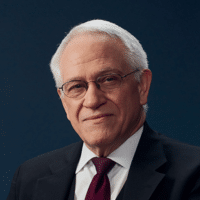Robert Corn-Revere is one of the most sought after free-speech and media attorneys in the United States. He is perhaps most well known for representing Playboy in a landmark Supreme Court decision, for serving as counsel to CBS in the "wardrobe malfunction" case, and for having comedian Lenny Bruce posthumously pardoned by former New York Governor George E. Pataki.
If you're not a comedy historian, or regular listener of the Joe Rogan Experience, you may not be aware that Lenny Bruce was a comedian and social critic who was arrested multiple times in the 1960's from San Francisco to New York and was ultimately convicted for performing “obscene” comedy routines. Without Lenny Bruce paving the way there would be no Richard Pryor, George Carlin, or the fictional Amazon Prime series The Marvelous Mrs. Maisel.
Today's author, Robert Corn-Revere, has been a defender of free-speech for decades.
Jim Caruso, the owner of Flying Dog Brewery, is a born rebel.
Last month, he won a First Amendment ruling against the North Carolina Alcoholic Beverage Control Commission, which had refused to approve the label for the brewery’s “Freezin’ Season Winter Ale.” Why? The state regulators claimed that Flying Dog’s label violated North Carolina law that prohibits label designs that depict “the use of alcoholic beverages in a scene” that they determined was “undignified, immodest, or in bad taste.”
Flying Dog’s labels use illustrations by gonzo artist Ralph Steadman, and the label for “Freezin’ Season” features the abstract image of a nude cartoon figure next to a campfire. There is a little nub of an appendage between the creature’s legs, which, depending on your proclivities, might be viewed as a stub of a tail or as a penis. Who’s to say? But this, the state’s reviewers concluded, was in “bad taste,” adding “the image below is seen as inappropriate to many here.”
But Jim Caruso was having none of it. The proudly calls Flying Dog a “First Amendment brewery,” a title earned through various battles with state regulators. Almost three decades ago he took on the Colorado Liquor Commission because it took issue with one of his labels that said “Good beer – no shit.” And just over a decade ago he opposed the Michigan Liquor Control Commission because it denied approval for his “Raging Bitch” brew on grounds the name was “vulgar.” Flying Dog won in each case, and with “Freezin’ Season,” the court held that the North Carolina commission could not prohibit a label just because some may be offended. The state may regulate beer labels, it said, but must do so within First Amendment limits.
Caruso was able to take this principled stand – and win – because of the rebels who came before him. Our society has never been short on those who believe their personal preferences should be written into law and enforced. Often, those people have broad political support or occupy positions of authority from which they can mandate their view of propriety. For that reason, lasting protections for free speech always emerge from those who are willing to buck the system. As Caruso told Reason Magazine last year, “All these battles are fought at the margin. That’s where everything controversial is. By the time you’re defending something mainstream, it’s too late.”
This was especially true in the mid twentieth century, a time of momentous cultural change, when many of the strong First Amendment protections we today take for granted were being forged by the courts. As the law stood in the 1950s, books could be banned for having a few naughty passages under a legal standard adopted from Victorian England in the nineteenth century. That wouldn’t change until 1957, when the Supreme Court “constitutionalized” the law of obscenity, making clear that sex and obscenity are not synonymous, and holding that for a work to be obscene, the government must consider the work as a whole, determine whether it appeals primarily to a prurient interest in sex, and prove that it lacks any redeeming social value.
Even before that welcome change in the law, Hugh Hefner decided the time was right to launch a new men’s magazine that was open about sex and featured pictures of naked women. The result was Playboy, and its first issue in 1953 showcased a nude photo of Marylin Monroe – a feature of the magazine that would evolve into the Playboy centerfold. The magazine was a hit from the beginning, and it became a cultural touchstone through the years that the Supreme Court struggled to make sense of its obscenity standard. Playboy had just reached its ten year anniversary when Justice Potter Stewart memorably (if unhelpfully) wrote in an opinion that he could not intelligibly define obscenity, “but I know it when I see it.”
Throughout these uncertain times, Hefner fought First Amendment battles in defense of Playboy, and his victories helped create stronger speech protections for all of us. These conflicts continued into the 1990s, when Congress adopted punitive regulations targeting Playboy Television, the company’s subscription cable television service. By then, Hef’s daughter, Christie, was at the company’s helm, and like her father, she did not shy away from a good First Amendment fight. She challenged the law and was victorious in the Supreme Court. Justice Anthony Kennedy’s opinion for the majority captured the essence of why a free speech case about an “adult entertainment channel” results in strong protections for society as a whole. He wrote in Playboy Entertainment Group, Inc. v. United States:
When a student first encounters our free speech jurisprudence, he or she might think it is influenced by the philosophy that one idea is as good as any other, and that in art and literature objective standards of style, taste, decorum, beauty, and esthetics are deemed by the Constitution to be inappropriate, indeed unattainable. Quite the opposite is true. The Constitution no more enforces a relativistic philosophy or moral nihilism than it does any other point of view. The Constitution exists precisely so that opinions and judgments, including esthetic and moral judgments about art and literature, can be formed, tested, and expressed. What the Constitution says is that these judgments are for the individual to make, not for the Government to decree, even with the mandate or approval of a majority.
Other cultural rebels had to fight these battles as well, sometimes at great personal risk.
Pathbreaking comedian Lenny Bruce was prosecuted for obscenity in several major U.S. cities for telling “dirty jokes” in nightclub performances. But Lenny was prosecuted more for transgressing then-existing social norms than for any supposed obscenity. He led the transformation of stand-up comics from being mere jokesters to social critics, and no subject was off-limits. His routines touched on everything from racism and organized religion to homosexuality and social conventions about the use of language. In 1964 he was convicted in New York for his routine at the Café Au Go Go in Greenwich Village, which the court found was “obscene, indecent, immoral and impure.” Lenny died before he could perfect his appeal, and this conviction remained on the books until the end of 2003, when Governor George Pataki issued the first posthumous pardon in the state’s history. Governor Pataki called it “a declaration of New York’s commitment to upholding the First Amendment.”
The pardon and changes in the law came too late to help Lenny, but his example is an inspiration to generations of stand-up comics, and as a cautionary tale to would-be censors who might be tempted to turn back the clock. And Lenny has made quite a comeback of late. A one-man show about Lenny’s career written and performed by Ronnie Marmo entitled “I’m Not a Comedian . . . I’m Lenny Bruce” is playing to rave reviews and enthralled audiences. And Lenny is pivotal character in the hit Prime Video Series “The Marvelous Mrs. Maisel.” Not bad for a comedian who’s been dead for nearly sixty years.
Time and again, the rebels prevail.
Simon Tam, the lead singer of the Asian-American rock group “The Slants,” challenged a decision of the U.S. Patent and Trademark Office to deny registering the band’s name under a provision of the Lanham Act that prohibited any trademarks that may “disparage … or bring … into contemp[t] or disrepute” any “persons living or dead.” Tam and his bandmates argued they chose their name precisely because of its negative connotations to “reclaim” the term in order to drain its denigrating force as a derogatory reference to Asian people. The Court agreed. Drawing on the solid foundation of First Amendment doctrine built in previous decades, Justice Alito wrote that the claim that the government has any ability to restrict “speech expressing ideas that offend … strikes at the heart of the First Amendment.”
Two years later, in 2019, the Supreme Court invalidated another provision of the law that prohibited registering “immoral or scandalous” trademarks. The rebel in this case was Erik Brunetti, an artist and entrepreneur who founded a clothing line that uses the trademark “FUCT.” Once again, drawing on its prior First Amendment cases, the Court held that the law’s restrictions were overly broad and discriminated against speech because of its content. In a concurring opinion, Justice Alito stressed that such discrimination “is poison to a free society.”
The world of commerce and the commercial speech that fuels it is now a freer place because of the First Amendment protections that were fashioned in cases brought by previous generations of free speech rebels. In October 2021, Flying Dog Brewery paid tribute to this legacy by issuing the first in a series of tribute beers – the first one called “Obscenity” and dedicated to Lenny Bruce. It is only fitting. The First Amendment struggles of Lenny, Hef, and others are the reason a business like Flying Dog can call itself a “First Amendment brewery.”



















